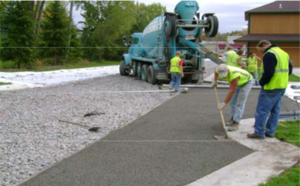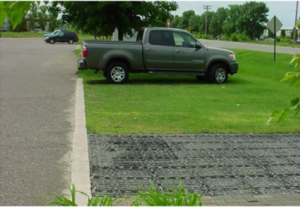
MS4 fact sheet - Pervious Pavements
Link to permeable pavement section of the manual
When rainfall hits impervious pavements such as conventional concrete and asphalt, the water runs off, collecting pollutants along the way and ends up in stormdrains and waterways. Pervious pavements allow water to pass through the surface and infiltrate into the soil below rather than running off impervious surfaces and into surface water. Pervious pavements include pervious asphalt, pervious concrete, pervious interlocking concrete pavers, plastic grid systems and amended soils. These pavements have the dual benefit of serving as a parking or drive surface and a stormwater management BMP.
This fact sheet provides an overview of the benefits associated with pervious pavements. In addition, examples of municipal ordinances and programs that incorporate pervious pavement into development and roadway reconstruction projects are provided.
Contents
Benefits and pollution reduction
Whether soil conditions favor infiltration or filtration, peak runoff rates are reduced and water quality treatment is afforded by using pervious pavements. Runoff volumes are reduced and ground water is recharged where underlying soils are suitable for infiltration. Numerous analyses of discharge from pervious pavement under-drains show that concentrations of suspended solids, total solids, phosphorus and nitrogen were lower than typical discharges from impervious surfaces, and that concentrations of copper, zinc and lead were also reduced.
Two long-term monitoring studies conducted in Rockville, MD, and Prince William, VA indicate removal efficiencies of 82 to 95 percent for sediment, 65 percent for total phosphorus, and 80 to 85 percent of total nitrogen (EPA, 1999). Removal efficiency is a function of introduced load/concentration, depth of filtration and materials used to filter. For more information, see the page on stormwater credits for permeable pavement.
When installed over a drainage storage bed, pervious pavements allow runoff to be stored and infiltrated into the surrounding soils or filtered, and collected by an under-drain system that discharges to the storm sewer system or directly to receiving waters. Pervious paving can reduce the size of engineered stormwater treatment facilities by reducing the amount of runoff needing treatment. Currently, the General Construction Permit will allow site designers to reduce the water quality volume sizing required when using pervious pavement, up to a maximum of ½ acre of new impervious surface.
During the winter months, water does not accumulate on the surface of pervious pavements unlike traditional impervious pavements preventing ice build-up. This decreases the need for using deicing agents such as sand and salt saving a municipality time and money. In addition, there is a decreased chance of a public safety hazard in pedestrian areas.
Program development and implementation
Types of pervious pavements
- Pervious asphalt - Pervious asphalt consists of fine and course aggregate stone bound by a bituminous-based binder. The amount of fine aggregate is reduced to allow for a larger void space of typically 15 to 20 percent. The installation at the Ramsey Washington Metro Watershed District offices in Little Canada, MN installed pervious asphalt in their parking lot.
- Pervious concrete - Pervious concrete is a mixture of Portland cement, fly ash, washed gravel, and water. Unlike conventional concrete, pervious concrete usually contains a void content of 15 to 25 percent which is achieved by the addition of a fine, washed gravel.
- Pervious interlocking concrete pavers - These pavers, when installed, form patterns that create openings through which rainfall can infiltrate. These openings, generally 8 to 20 percent of the surface area, are typically filled with pea gravel aggregate. Pervious pavers have been used as an asphalt alternative in cul-du-sacs in Woodbury, MN.
- Plastic grid systems - Plastic grid systems, sometimes referred to as geocells, consist of flexible plastic interlocking units that allow for infiltration through large gaps filled with gravel or topsoil planted with turf grass. Empty grids are usually at least 90 percent open space, so void space depends on the fill media.
- Amended soils - Soil amendments add fiber or artificial media to soil to maintain soil structure and prevent compaction (see the Volume Control Using Compost Materials Soil Amendments fact sheet). The Minnesota Landscape Arboretum has designated an area of the parking lot for testing infiltration rates of several different installations of pervious pavements. This exhibit includes information to educate the public on how the various surfaces work.
Example ordinances and intiatives
Typical applications for permeable paving include commercial and light industrial parking lots, sidewalks, trails, driveways, residential access roads and emergency and facility maintenance roads. Examples of municipal ordinances and initiatives, which encourage the use of pervious pavements include the following.
- City of Inver Grove Heights, Northwest Area Ordinance - For all development within this nearly 3,000 acre area of the city, pervious pavements must be used for the portion of parking over the minimum required off-street parking spaces. If proposed parking exceeds the maximum required off-street parking spaces, 50 percent of all parking spaces shall be pervious pavement.
- Chicago Green Alleyway Program - The program began as a pilot in 2006, and through 2008, more than 80 green alleys have been installed. Of the four design approaches piloted, three incorporate pervious pavements with underlying infiltration or filtration.
- Seattle Green Streets - Permeable pavements can be used to achieve City of Seattle water quality requirements and flow control requirements. While street surface demonstrations are currently being studied, at this time, pervious pavements are limited to non-street surfaces, such as sidewalks and driveways.
- City of Vancouver Country Lane Projects - With the first "country lane" project, various types of road surfaces were incorporated in combination to create an environmentally friendly lane. The design of the first lane included the use of pervious pavers, plastic mats and formed concrete driving strips.
- State of North Carolina - In 2007, the North Carolina Legislature enacted a law (Bill H1473) that requires 20 percent of a parking lot to be made of pervious pavement or a suitable, environmentally-friendly alternative stormwater management practice.
Maintenance considerations
Permeable pavement maintenance should include vacuum sweeping annually at a minimum. Additional vacuuming is needed if sediment is visibly accumulating and clogging the pores of the surface. High-pressure washing may also be necessary to free pores in the top layer from clogging. Potholes and cracks can be filled with patching mixes unless more than 10 percent of the surface area needs repair. Some restriction on the use of sand or anti-skid material might be needed if repeated use shows an accumulation is problematic.
Typical cost
Construction costs of pervious pavements should be viewed with caution, given the wide range of site conditions and design requirements. It is recommended that each potential application be evaluated on a site-by-site basis. However, a range of cost estimates for the basic installation of pervious paver materials (including minimum base requirements) is given below for comparison purposes. These costs should not be compared directly to the cost of conventional pavements because pervious pavements are also stormwater management systems. An accurate price comparison would include the costs for full stormwater management and paving systems; that is, curbs, gutters, piping and storage.
- Permeable asphalt: 4 to $9 per square foot
- permeable concrete: 6 to $12 per square foot
- Permeable pavers: 7 to $15 per square foot
- Plastic grid system: 3 to $9 per square foot
- Amended soils: 12 to $16 per square foot
This page was last edited on 23 January 2023, at 23:26.


